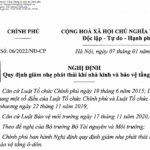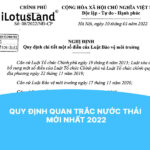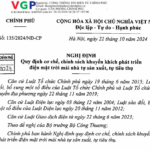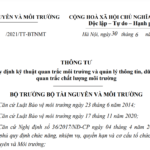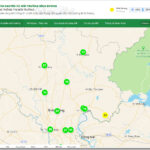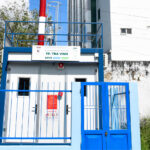Waste disposal has become an increasingly critical issue in modern society, with rapid industrial development and population growth. In this context, understanding wastewater, its characteristics, classification, and processing procedures according to regulations is crucial for protecting the environment and community health. This article delves into the important aspects of this issue.
Wastewater
What is wastewater?
According to Government Decree No. 38/2015/NĐ-CP: On waste and scrap management, there are definitions related to wastewater. So what is wastewater? Let's define some terms related to wastewater.
- Wastewater is water that has undergone changes in characteristics and properties discharged from production, business, services, household, or other activities.
- Solid waste is waste in solid or sludge form discharged from production, business, services, household, or other activities.
- Normal waste is waste that is not classified as hazardous waste or falls into the hazardous waste category but with hazardous factors below the hazardous waste threshold.
- Household solid waste (also known as household waste) is solid waste generated in the daily activities of humans.
- Industrial solid waste is waste generated from production, business, services.
Wastewater In English Wastewater is referred to as wastewater – water that has been used and is polluted due to containing sediment, chemicals, and bacteria. This water typically originates from various sources such as households, industries, and agriculture. There are two main types of wastewater: liquid and solid waste.

Characteristics of wastewater
The characteristics of wastewater depend on its source and production processes. Wastewater often contains many compounds that can be harmful to the environment and human health. Common characteristics include unpleasant odor, dark color, and variable pH. Additionally, wastewater may contain substances such as heavy metals, dioxins, and radioactive materials, depending on its origin.
2.1. Odor and Color
Unpleasant odor and dark color of wastewater are often the most visible signs of pollution. Organic compounds and microorganisms cause the unpleasant odor, while the color varies depending on the present chemicals.
2.2. pH Level
The pH of wastewater often fluctuates due to the mixing of chemicals and microorganisms. This can affect the effectiveness of wastewater treatment processes.
2.3. Pollution Concentration
Wastewater often contains high concentrations of pollutants such as dioxins, pesticides, and heavy metal compounds like mercury and lead. Elevated concentrations pose significant risks to the environment and human health.
2.4. Hazardous Chemicals
Wastewater often contains hazardous chemicals such as phenol, formaldehyde, and various hydrocarbon forms. These substances can have negative effects on the ecosystem and the surrounding community's health.
2.5. Temperature
Wastewater from industrial sources typically has a higher temperature than domestic wastewater. This temperature difference can significantly impact the aquatic ecosystem that receives the discharged wastewater.
Origin of wastewater
- Domestic wastewater: from daily human activities, including water from showers, kitchens, and toilets.
- Industrial wastewater: from production and processing activities in factories and plants.
- Agricultural wastewater generated from the use of fertilizers, pesticides, and water runoff in agricultural areas.
- Rainwater runoff: Rainwater flowing over the ground, picking up pollutants from streets, construction sites, and other polluted areas.
- Wastewater from specific industries: arising from industries such as oil refining, mineral extraction, and paper production.
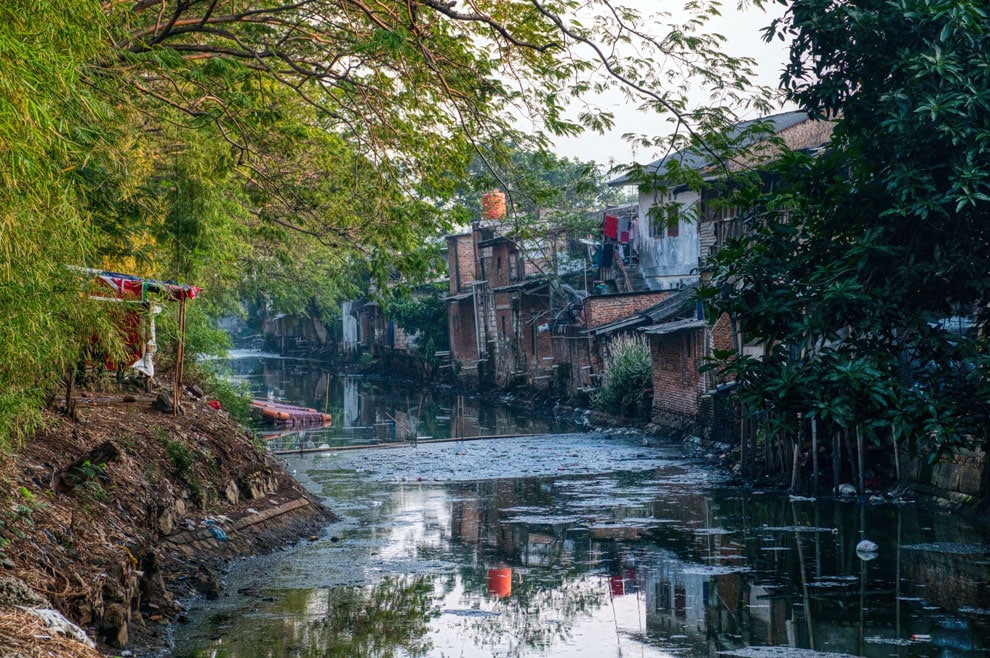
Latest Government regulations on Waste and Scrap Management
Government Decree No. 38/2015/NĐ-CP: On waste and scrap management
| Symbol number | 38/2015/NĐ-CP |
| Date issued | 24-04-2015 |
| Effective date | 15-06-2015 |
| Document type | Decree |
| Agency issued | Government |
| Signer | Nguyen Tan Dung |
| Abstract | Waste and Scrap Management |
| Attachments | Decree No. 38/2015/NĐ-CP |
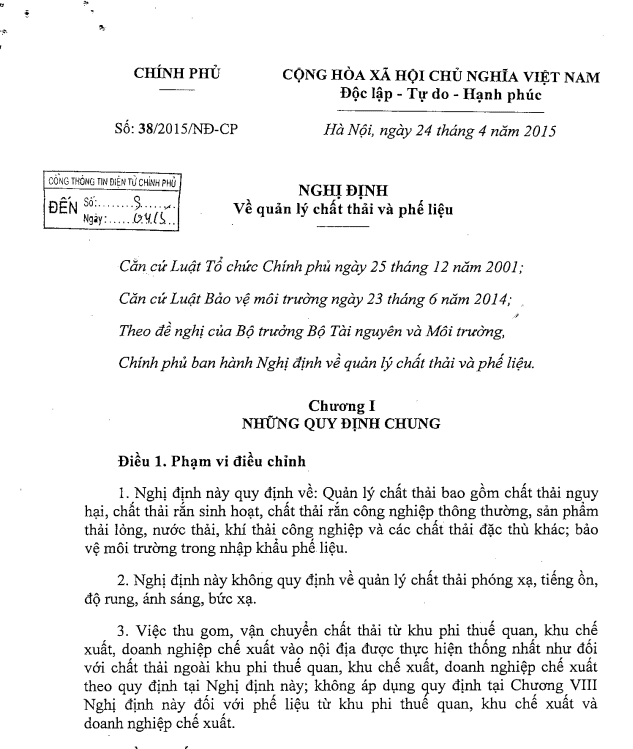
Registration of hazardous waste sources
Entities responsible for hazardous waste sources must register with the Department of Natural Resources and Environment in one of the following forms:
a) Prepare a registration file to be granted a Hazardous Waste Source Registration Certificate (hereinafter referred to as the hazardous waste source registration procedure);
b) Integrate into the hazardous waste management report and do not need to carry out the hazardous waste source registration procedure for certain special cases (cases where the hazardous waste source has limited quantities, types, and operating times);
c) Register online through the information system with complete information similar to preparing a file as specified in Point a, Clause 1, Article 6 of Decree No. 38/2015/NĐ-CP of the Government.
Responsibilities of hazardous waste handlers
Sign contracts for the collection, transportation, and treatment of hazardous waste with hazardous waste source entities within the operational area stated in the Hazardous Waste Treatment License; receive, transport, and treat the quantity and type of hazardous waste using vehicles, systems, and equipment permitted according to the content of the contract, hazardous waste documents, and Hazardous Waste Treatment License.
Fulfill the responsibilities of hazardous waste source entities for hazardous waste generated from activities without the ability to handle. In cases where all hazardous waste is completely treated, the hazardous waste handler is not required to fulfill the responsibilities of the hazardous waste source entity.
Complete all contents of the hazardous waste treatment license registration dossier confirmed by the Ministry of Natural Resources and Environment and attached to the License. This dossier is a specific basis for environmental management and monitoring of hazardous waste handler activities.
Notify in writing the hazardous waste source entity and report to the Ministry of Natural Resources and Environment (in a separate written document or integrated into the periodic hazardous waste management report) in case there is a temporary need to retain hazardous waste that has not been treated within 06 (six) months from the date of the transfer recorded on the hazardous waste document.
…
Responsibilities of the Department of Natural Resources and Environment in hazardous waste management
- Manage the activities and records, reports, contracts, documents of hazardous waste source entities within their local scope (including hazardous waste source entities exempted from the hazardous waste source registration procedure).
- Update the hazardous waste database and implement hazardous waste source registration, declaration of hazardous waste documents, and online periodic hazardous waste management reporting at the local level; enhance the use of information systems or email during the hazardous waste source registration process.
- Report to the provincial People's Committee and the Ministry of Natural Resources and Environment on the situation of hazardous waste management, hazardous waste source registration, and report deadlines before March 31 of the following year.
Monitor wastewater discharge
1. The wastewater discharge activities of production, business, service establishments, and industrial zones must be regularly monitored according to the approved environmental impact assessment report, confirmed environmental protection plan, or equivalent documents as stipulated by law.
2. Industrial zones must install automatic continuous wastewater monitoring systems, directly transmit data to the local Department of Natural Resources and Environment.
3. Production, business, service establishments outside industrial zones with a wastewater discharge scale of 1,000 m3/day or more (excluding cooling water) must install automatic continuous wastewater monitoring systems and directly transmit data to the local Department of Natural Resources and Environment.
4. Encourage production, business, and service establishments outside industrial zones with wastewater discharge below 1,000 m3/day (excluding cooling water) and potential environmental harm to install automatic continuous wastewater monitoring equipment.
Thus, the above provides an overview of waste and some government regulations on Waste and Scrap Management. View detail here.
